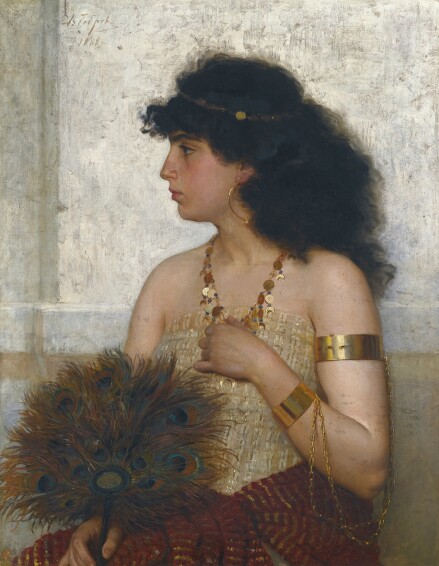- 310
Viktor Alexeevich Bobrov
Estimate
40,000 - 60,000 GBP
bidding is closed
Description
- Viktor Alexeevich Bobrov
- Esther
- signed in Cyrillic and dated 1888 t.l.
- oil on canvas
- 79 by 62cm, 31 by 24 1/2 in.
Provenance
Acquired by the grandfather of the present owner in Russia in the early 1920s
Literature
F.Bulgakov, Nashi khudozhniki, St Petersburg, 1890 (reprinted 2002), p.42, listed under works from 1888
Condition
Original canvas. There are frame abrasions along the edges with some associated paint loss. There is a scratch approximately 3 cm in length from the top edge to the left of the signature. There is craquelure throughout with some associated flecks of paint loss. The paint surface is covered by a layer of dirt. Examination under UV light is impaired by a thick layer of discoloured varnish. Held in a wooden frame. Unexamined out of frame.
"In response to your inquiry, we are pleased to provide you with a general report of the condition of the property described above. Since we are not professional conservators or restorers, we urge you to consult with a restorer or conservator of your choice who will be better able to provide a detailed, professional report. Prospective buyers should inspect each lot to satisfy themselves as to condition and must understand that any statement made by Sotheby's is merely a subjective, qualified opinion. Prospective buyers should also refer to any Important Notices regarding this sale, which are printed in the Sale Catalogue.
NOTWITHSTANDING THIS REPORT OR ANY DISCUSSIONS CONCERNING A LOT, ALL LOTS ARE OFFERED AND SOLD AS IS" IN ACCORDANCE WITH THE CONDITIONS OF BUSINESS PRINTED IN THE SALE CATALOGUE."
"In response to your inquiry, we are pleased to provide you with a general report of the condition of the property described above. Since we are not professional conservators or restorers, we urge you to consult with a restorer or conservator of your choice who will be better able to provide a detailed, professional report. Prospective buyers should inspect each lot to satisfy themselves as to condition and must understand that any statement made by Sotheby's is merely a subjective, qualified opinion. Prospective buyers should also refer to any Important Notices regarding this sale, which are printed in the Sale Catalogue.
NOTWITHSTANDING THIS REPORT OR ANY DISCUSSIONS CONCERNING A LOT, ALL LOTS ARE OFFERED AND SOLD AS IS" IN ACCORDANCE WITH THE CONDITIONS OF BUSINESS PRINTED IN THE SALE CATALOGUE."
Catalogue Note
Oil paintings by Bobrov are exceptionally rare, hardly found even in museum collections. During the 1860s and 1870s he was best known for his engravings and watercolours, but with the advent of photography in the late 1880s he turned to oil painting again and joined Alexei Harlamoff and Konstantin Makovsky in the increasingly popular genre of Salon portraiture. Bobrov would paint the same model repeatedly in different poses, dressed up in contemporary or historical costume. A repetition of the theme of the present work can be found in a 1905 postcard published in Zabitye imena. Russkaya zhivopis’ XIX veka (fig.1).
Bobrov was famously inspired by Rembrandt, and may well have modelled his Esther on the Dutch master’s Ahasuerus and Haman at the Feast of Esther (1660, The Pushkin State Museum of Fine Arts), though the Jewish queen of the Persian king Xerxes, Esther was an exotic subject that appealed to the late Victorian and Orientalist aesthetic across Europe.
Bobrov was famously inspired by Rembrandt, and may well have modelled his Esther on the Dutch master’s Ahasuerus and Haman at the Feast of Esther (1660, The Pushkin State Museum of Fine Arts), though the Jewish queen of the Persian king Xerxes, Esther was an exotic subject that appealed to the late Victorian and Orientalist aesthetic across Europe.

